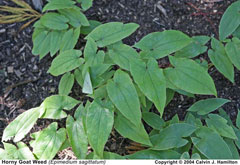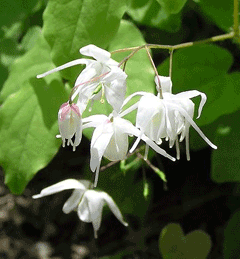 |
|
|
 |
| http://flickr.com/photos/98083017%40N00/ |
Translate this page:
Summary
Physical Characteristics

 Epimedium sagittatum is a PERENNIAL growing to 0.5 m (1ft 8in) by 0.4 m (1ft 4in).
Epimedium sagittatum is a PERENNIAL growing to 0.5 m (1ft 8in) by 0.4 m (1ft 4in).
See above for USDA hardiness. It is hardy to UK zone 6 and is not frost tender. It is in flower from May to June. The species is hermaphrodite (has both male and female organs) and is pollinated by Bees. The plant is not self-fertile.
Suitable for: light (sandy), medium (loamy) and heavy (clay) soils. Suitable pH: mildly acid, neutral and basic (mildly alkaline) soils. It can grow in semi-shade (light woodland). It prefers dry or moist soil.
UK Hardiness Map
US Hardiness Map
Synonyms
E. sinense.
Plant Habitats
Woodland Garden Dappled Shade; Shady Edge; Ground Cover;
Edible Uses
Edible Parts: Leaves
Edible Uses:
Young plant and young leaves - cooked[105]. Soaked and then boiled[177]. (This suggests that the leaves are bitter and need to be soaked in order to remove the bitterness.)
References More on Edible Uses
Medicinal Uses
Plants For A Future can not take any responsibility for any adverse effects from the use of plants. Always seek advice from a professional before using a plant medicinally.
Antirheumatic Aphrodisiac Carminative Expectorant Infertility Kidney Ophthalmic Tonic
Vasodilator
The whole plant is antirheumatic, aphrodisiac, carminative, expectorant, ophthalmic and vasodilator. Used as a kidney tonic, it also treats sterility and barrenness[147, 178, 238]. It is taken internally in the treatment of asthma, bronchitis, cold or numb extremities, arthritis, lumbago, impotence, involuntary and premature ejaculation, high blood pressure and absentmindedness[238]. It should be used with some caution since in excess it can cause vomiting, dizziness, thirst and nosebleeds[238]. The plant is harvested in the growing season and dried for later use[238].
References More on Medicinal Uses
The Bookshop: Edible Plant Books
Our Latest books on Perennial Plants For Food Forests and Permaculture Gardens in paperback or digital formats.

Edible Tropical Plants
Food Forest Plants for Hotter Conditions: 250+ Plants For Tropical Food Forests & Permaculture Gardens.
More

Edible Temperate Plants
Plants for Your Food Forest: 500 Plants for Temperate Food Forests & Permaculture Gardens.
More

More Books
PFAF have eight books available in paperback and digital formats. Browse the shop for more information.
Shop Now
Other Uses
References More on Other Uses
Cultivation details
Succeeds in any fertile humus-rich soil[200], preferring a moist but well-drained peaty loam[1, 280]. Grows best in the light dappled shade of a woodland[200, 280]. Plants can succeed in the dry shade of trees[233]. A shallow-rooting plant, the rhizomes creeping just below the soil and the finer roots occupying the top 30cm of the soil[280]. Although the plants are hardy to at least -15°c, the young growth in spring can be killed by frosts[238]. Grows well in the rock garden or wild garden[1]. Plants are self-sterile and so more than one clone is required for cross-fertilization in order for seed to be produced. Plants will often hybridise with other species growing nearby[280]. Cultivated as a medicinal plant in Japan[58]. Members of this genus are rarely if ever troubled by browsing deer or rabbits[233].
References Carbon Farming Information and Carbon Sequestration Information
Temperature Converter
Type a value in the Celsius field to convert the value to Fahrenheit:
Fahrenheit:
The PFAF Bookshop
Plants For A Future have a number of books available in paperback and digital form. Book titles include Edible Plants, Edible Perennials, Edible Trees,Edible Shrubs, Woodland Gardening, and Temperate Food Forest Plants. Our new book is Food Forest Plants For Hotter Conditions (Tropical and Sub-Tropical).
Shop Now
Plant Propagation
Seed - best sown in a cold frame as soon as it is ripe in late summer[200, 280]. Sow stored seed as early as possible in the year in a cold frame. Prick out the seedlings into individual pots when they are large enough to handle and grow them on in light shade in the cold frame or greenhouse for at least their first winter[K]. Plant them out in mid to late summer[K]. Division in July/August according to one report, in late spring according to another[200]. Larger clumps can be replanted direct into their permanent positions, though it is best to pot up smaller clumps and grow them on in a cold frame until they are rooting well. Plant them out in the spring. Cuttings in late summer[200].
Other Names
If available other names are mentioned here
Native Range
TEMPERATE ASIA: China (Anhui Sheng, Fujian Sheng, Guangdong Sheng, Guangxi Zhuangzu Zizhiqu, Guizhou Sheng, Hubei Sheng, Hunan Sheng, Jiangxi Sheng, Zhejiang Sheng), Taiwan
Weed Potential
Right plant wrong place. We are currently updating this section.
Please note that a plant may be invasive in one area but may not in your area so it's worth checking.
Conservation Status
IUCN Red List of Threatened Plants Status :

Growth: S = slow M = medium F = fast. Soil: L = light (sandy) M = medium H = heavy (clay). pH: A = acid N = neutral B = basic (alkaline). Shade: F = full shade S = semi-shade N = no shade. Moisture: D = dry M = Moist We = wet Wa = water.
Now available:
Food Forest Plants for Mediterranean Conditions
350+ Perennial Plants For Mediterranean and Drier Food Forests and Permaculture Gardens.
[Paperback and eBook]
This is the third in Plants For A Future's series of plant guides for food forests tailored to
specific climate zones. Following volumes on temperate and tropical ecosystems, this book focuses
on species suited to Mediterranean conditions—regions with hot, dry summers and cool, wet winters,
often facing the added challenge of climate change.
Read More
Expert comment
Author
(Siebold.&Zucc.)Maxim.
Botanical References
200280
Links / References
For a list of references used on this page please go here
Readers comment